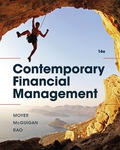
EBK CONTEMPORARY FINANCIAL MANAGEMENT
14th Edition
ISBN: 9781337514835
Author: MOYER
Publisher: CENGAGE LEARNING - CONSIGNMENT
expand_more
expand_more
format_list_bulleted
Question
Chapter 2, Problem 7P
Summary Introduction
To determine: The holding period
Expert Solution & Answer
Want to see the full answer?
Check out a sample textbook solution
Students have asked these similar questions
Need answer.
Solve plz now
Precious metal qn solve .
Chapter 2 Solutions
EBK CONTEMPORARY FINANCIAL MANAGEMENT
Ch. 2.A - Prob. 1QTDCh. 2.A - Prob. 2QTDCh. 2.A - Prob. 3QTDCh. 2.A - Prob. 1PCh. 2.A - Prob. 2PCh. 2.A - Prob. 3PCh. 2.A - Prob. 4PCh. 2.A - Prob. 5PCh. 2.A - Prob. 6PCh. 2.A - Prob. 7P
Ch. 2.A - Prob. 8PCh. 2 - Prob. 1QTDCh. 2 - Prob. 2QTDCh. 2 - Prob. 3QTDCh. 2 - Prob. 4QTDCh. 2 - Prob. 5QTDCh. 2 - Prob. 6QTDCh. 2 - Prob. 7QTDCh. 2 - Prob. 8QTDCh. 2 - Prob. 9QTDCh. 2 - Prob. 10QTDCh. 2 - Prob. 1PCh. 2 - Prob. 2PCh. 2 - Prob. 3PCh. 2 - Prob. 4PCh. 2 - Prob. 5PCh. 2 - Prob. 6PCh. 2 - Prob. 7PCh. 2 - Prob. 8PCh. 2 - Prob. 9PCh. 2 - Prob. 10PCh. 2 - Prob. 11PCh. 2 - Prob. 12PCh. 2 - Prob. 13P
Knowledge Booster
Learn more about
Need a deep-dive on the concept behind this application? Look no further. Learn more about this topic, finance and related others by exploring similar questions and additional content below.Similar questions
arrow_back_ios
SEE MORE QUESTIONS
arrow_forward_ios
Recommended textbooks for you
 EBK CONTEMPORARY FINANCIAL MANAGEMENTFinanceISBN:9781337514835Author:MOYERPublisher:CENGAGE LEARNING - CONSIGNMENT
EBK CONTEMPORARY FINANCIAL MANAGEMENTFinanceISBN:9781337514835Author:MOYERPublisher:CENGAGE LEARNING - CONSIGNMENT

EBK CONTEMPORARY FINANCIAL MANAGEMENT
Finance
ISBN:9781337514835
Author:MOYER
Publisher:CENGAGE LEARNING - CONSIGNMENT
Internal Rate of Return (IRR); Author: The Finance Storyteller;https://www.youtube.com/watch?v=aS8XHZ6NM3U;License: Standard Youtube License